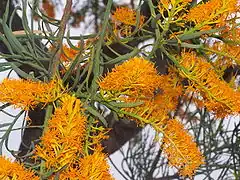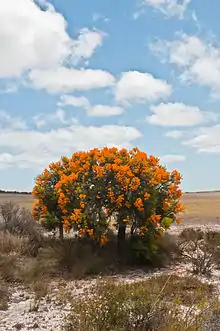Nuytsia floribunda
Nuytsia floribunda, appelé communément l'« arbre de Noël de l'Australie occidentale », est un arbre parasite rencontré dans cet état. Il est célèbre pour ses fleurs d'un jaune brillant qui s'épanouissent autour de Noël (en été en Australie). Il peut atteindre 10 mètres de haut et fait partie de la famille des Loranthaceae comme le gui.


C'est un hémiparasite: il est capable de faire la photosynthèse mais emprunte l'eau et les sels minéraux à son hôte. Les racines de la plante se fixent sur les racines des plantes voisines et accaparent leurs nutriments ce qui peut ralentir la croissance de la plante parasitée sans en provoquer la mort. Les racines peuvent aussi s'enrouler autour de câbles souterrains, les confondant avec des racines.
Taxonomie
Initialement décrite par Labillardière et nommée Loranthus floribundus[1], mais plus tard nommée Nuytsia floribunda par Robert Brown[2]
.jpg.webp)
.jpg.webp)
Références
- Novae Hollandiae Plantarum Specimen 1: 87. 1805
- Don, G., (1834) A General History of Dichlamydeous Plants 3: 432 (comb. nov.)
- (en) Référence FloraBase (Australie-Occidentale) : classification Nuytsia floribunda
- (en) Référence NCBI : Nuytsia floribunda (taxons inclus)
- (en) Référence GRIN : espèce Nuytsia floribunda (Labill.) R. Br.
- Calladine, Ainsley and Pate, John S. 2000. Haustorial structure and functioning of the root hemiparastic tree Nuytsia floribunda (Labill.) R.Br. and water relationships with its hosts. Annals of Botany
- Association of Societies for Growing Australian Plants (ASGAP) Nuytsia floribunda
- Thomas Göbel: Heilpflanzen gegen Krebs und Psychose, Nuytsia Floribunda und Viscum Album, Betrachtung und Beurteilung zweier polarer Pflanzencharaktere und ihre Anwendungsmöglichkeiten. Verlag Freies Geistesleben, Stuttgart/Allemagne 2004, (ISBN 3-7725-2230-0)
- Don, G., (1834) A General History of Dichlamydeous Plants 3: 432 (comb. nov.)